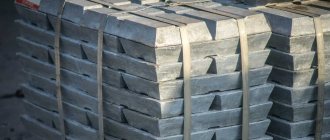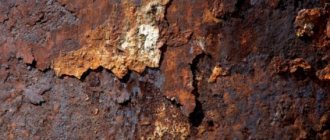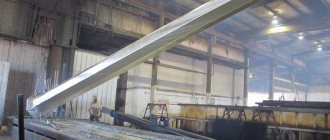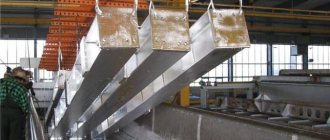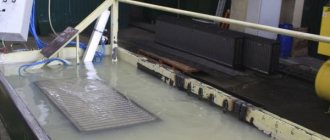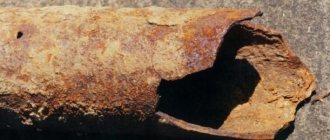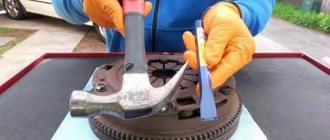Thermal diffusion treatment of metal surfaces with zinc (sherardization) is a relatively new method of processing metal structures.
Despite this, thermal diffusion technology has become widespread among specialized specialists.
This is due to the stable protective properties and performance characteristics of the processed products.
Thermal diffusion galvanizing of metal: pros and cons
The undeniable advantages of the technology include:
- excellent adhesion of the zinc layer to the metal surface;
- compared to hot galvanizing - compact equipment, the ability to work in small areas;
- low labor costs, and therefore cost-effective;
- coating durability;
- evenness of the layer, the ability to adjust its thickness during application;
- harmlessness to personnel and the environment;
- almost complete zero waste - the products remaining after processing are easily disposed of;
- simplicity and energy intensity of technology.
However, thermal diffusion galvanizing of metal also has disadvantages.
Products galvanized in this way lose in aesthetics: they have a dull grayish tint. The problem can be solved by applying a decorative coating over galvanization. Although for purely technical parts, the “mouse” color is not of fundamental importance. A much bigger disadvantage is that the possibilities of galvanizing parts directly depend on the size of the chamber. And it is usually very compact. Therefore, this technology is not suitable for protecting large-sized rolled products.
Features of technology and scope of application
This processing method provides metal structures with reliable anti-corrosion protection, and also prevents premature wear of the metal, as a result, it allows for an increase in service life. The technique is based on the process of diffusion of metal molecules, carried out at temperatures from 400 to 470 ° C. Due to this, molecules of the alloying substance – zinc – diffuse into the surface layer of the structure. The features of the thermal diffusion process are specified in the profile standard - GOST R 9.316-2006.
The use of this technology makes it possible to create a uniform zinc layer on the surface of metal structures. The main feature of the method is that the zinc layer is uniform even in hard-to-reach areas of the workpiece (cavities, holes, etc.).
Thermal diffusion technology is usually used to process the following structures and parts:
- Protective structures for bridges and roads;
- Accessories used in the furniture industry;
- Valves used in the oil and gas industry;
- Reinforcement used to strengthen railway tracks;
- Elements of pipelines used in the creation of utilities and fittings used in the construction industry;
- Structural elements of power lines;
- Separate parts of motor vehicles.
Using thermal diffusion galvanizing on metal structures, it is possible to create a zinc layer of minimal thickness. Therefore, products with small dimensions can be subjected to this treatment.
It is worth noting that processing parts at a maximum temperature increase (up to 470 °C) leads to an increase in the intensity of the process of thermal diffusion of zinc molecules. Therefore, the coating does not acquire the necessary performance characteristics. This coating is characterized by a low level of anti-corrosion protection, high fragility and a high level of peeling of the zinc layer.
To create a zinc coating of the required thickness, which will have high protective properties, it is important to carry out a number of additional measures:
- Before processing, the metal surface should be thoroughly cleaned;
- It is necessary to create absolute tightness of the container in which thermal diffusion galvanizing is carried out;
- An inert and reducing environment should be created in a sealed box, since zinc coating cannot be applied in an oxidizing environment.
During the process of applying zinc coating, it is advisable to additionally add activators (special fluxing elements) to the working environment.
Thermal diffusion galvanizing technology
How does thermal diffusion galvanizing work in Moscow?
It is based, as you can guess from the name, on the physical process of diffusion - the penetration of zinc molecules into the metal environment. It occurs under the influence of high temperature - from +400 to +470 degrees. If during cold galvanizing it is difficult or impossible to reach some areas, due to diffusion the coating covers the most inaccessible corners. When heating, it is not recommended to reach the “critical” 470 degrees - the higher the temperature at which the process occurs, the weaker the coating becomes. During operation, it can easily peel off, which will reduce the protective functions to zero.
Galvanizing methods
The chosen galvanizing method affects the final result, since with each method metal products acquire different properties:
- Thickness of the protective layer . For large structures it is better to use a thicker coating, but for small parts it is necessary to select the optimal thickness of the protective coating that does not reduce performance characteristics.
- Uniformity . For small parts, uniformity of coverage over the entire area is important, but for large items this parameter is not so important.
- Strength of retention of the protective layer on the metal. This parameter depends on the chosen galvanizing technology. When using hot and thermal diffusion galvanizing, the joining of metals occurs at the molecular level, which ensures reliable retention of the protective coating.
- Appearance . After galvanizing, the surface can become matte or glossy, and also have different colors - from dark gray to blue.
- Resistance to mechanical stress . The higher the level of protection, the more reliably the parts are protected from corrosion.
- Self-healing . This parameter depends on the thickness of the applied layer.
- Resistance to corrosion processes . This property is influenced by all factors - layer thickness, uniformity of application, resistance to mechanical stress, etc.
Galvanizing technology affects the performance properties of metal structures. In modern industry, the two most popular methods are:
- Hot galvanizing . Involves immersing parts in a solution of molten zinc.
- Thermal diffusion galvanizing . The formation of a protective coating is carried out by placing parts in an environment with powdered zinc.
Hot galvanizing
This process involves immersing metal parts in molten zinc.
Products galvanized in this way have a wide range of operational advantages. The technology consists of several stages:
- Parts that need processing are placed in the hanging area , where they are mounted on movable crossheads. They are fixed on them so that the sections can be conveniently lowered into technological containers. At the same time, when hanging, effective contact with liquids is ensured, so that the parts do not interfere with each other.
- Before immersion in zinc, parts undergo several stages of pre-treatment - degreasing, cleaning, pickling, removing acid residues, fluxing. At this stage, the metal heats up slightly to prevent deformation during sudden temperature changes.
- Drying and heating . Multi-stage ovens are supplied with clean, heated air. It allows you to thoroughly remove pre-treatment residues from the surface and heats the parts to the required temperature.
- Galvanizing . Traverses with prepared metal products are placed in a closed furnace, where containers with molten zinc are located (its temperature is about 450 degrees Celsius). The furnace must ensure tightness to protect the work of personnel and prevent the release of gases into the atmosphere, which must undergo additional purification before being released into the atmosphere. The thermal energy from these furnaces is reused in other technological processes.
- After galvanizing, the traverse with attached parts is sent to the removal and sorting .
The hot-dip galvanizing method remains one of the most effective and easiest to implement, and also does not require large economic costs. With this galvanizing, metal structures acquire optimal protection against corrosion. Advantages:
- Low cost of the technological process.
- Use of technological lines with high productivity.
- Ability to galvanize large and large parts.
- The thickness of the protective layer can vary between 40-200 microns.
- Strength of retention of the zinc layer on structures due to the penetration of zinc molecules into the crystal lattice of the metal.
- Resistance of structures to mechanical stress.
- Good self-healing ability.
- Corrosion resistance.
This method also has some disadvantages:
- Inability to make a zinc layer less than 45 microns.
- Unstable coating uniformity.
- The appearance of the products is not very presentable.
Hot-dip galvanizing is the optimal protection option for large and large structures that require reliable and long-lasting corrosion protection. It is not advisable to use it for processing small structures that require high precision in layer thickness or uniformity of coating. In this way, it is impossible to process stationary metal products outside the walls of the production workshop.
Equipment for thermal diffusion galvanizing
Thermal diffusion galvanizing equipment in the Moscow region may differ in complexity, and therefore in capabilities.
It is not individual units that have the greatest potential, but lines on which a part or group of parts undergo step-by-step operations. The optimal equipment for pre-cleaning is a shot blasting unit. To supply parts to the furnace, elements such as a loader and a conveyor are used. And the already processed rolled products are removed using another conveyor - an unloading conveyor. The furnace in which the key process takes place must have increased heat resistance and be completely sealed.
Complete diffusion galvanizing lines must also be equipped with a separator, vibrator, sifter, and containers in which already processed parts are passivated and washed. The finishing point of the line is the receiver of the finished product.
Galvanizing is carried out in an inert or reducing environment. Activators that perform fluxing functions can be additionally loaded into the chamber.
The essence and purpose of thermal diffusion galvanizing
At the dawn of the technology, more than a hundred years ago, it was called Sherardization, named after its inventor, the Englishman Sherard Cowper-Coles.
Later, the long and not very euphonious term was abandoned, focusing on the process. Before the introduction of thermal diffusion galvanizing, an unreliable and labor-intensive galvanic method was used, which had many disadvantages. With the growth of technical progress, and specifically with the creation of the first closed autoclaves, it became possible to use zinc vapors for galvanizing. The main and only purpose of the technology is to protect the metal. Of course, even the layer applied by thermal diffusion galvanizing does not last forever. It will take the blow of external environments, especially aggressive ones, and will gradually begin to collapse. But this is a very slow process that will continue not for years, but for decades.
Thermal diffusion galvanizing is a reliable method of anti-corrosion coating
In addition to 100% protection, the metal acquires other useful properties.
Unlike other methods, in which the linear dimensions of the workpieces increase, albeit slightly, the coating obtained by the diffusion method penetrates deep into the workpiece, without disturbing its contours. This is especially important when processing products such as gratings with small mesh. The reliability of the method does not decrease depending on the complexity of the part: thermal diffusion galvanizing in Moscow is equally available for workpieces with threads, internal cavities, solid and welded.
Advantages and disadvantages of technology
The thermal diffusion method of metal processing, unlike other technologies, has a number of obvious advantages:
- The zinc coating applies evenly, and the surface acquires good adhesion and stable protective qualities.
- The technology is cost-effective because its application does not require large production areas, and the costs of electricity and labor are minimal.
- Since diffusion processing of rolled products is carried out in sealed boxes, this technology is characterized by chemical and toxic safety, and is also environmentally friendly. Moreover, the workflow eliminates the possibility of specialists receiving thermal burns.
- Cleaning the surface of products after treatment with a layer of zinc is carried out without the use of acids and other chemically aggressive compounds.
- It is possible to adjust the thickness of the zinc coating, and in a wide range depending on the established requirements.
- The waste generated during thermal diffusion galvanizing is easy to dispose of, which is carried out according to a standard scheme, eliminating the danger to human health.
- Diffusion galvanizing of metal surfaces is carried out using equipment that is easy to operate and maintain.
- Unlike other technologies used for processing metal structures with zinc, thermal diffusion coating is carried out at a gentle temperature.
Comparative analysis of corrosion resistance
Despite many advantages, this technology also has some disadvantages, including:
- The surface after treatment has an unaesthetic gray color. To increase the attractiveness of the coating, an additional decorative layer must be applied to the previously created zinc layer. However, the possibility of applying a decorative layer is not provided for by the requirements of current GOSTs. Therefore, if the decorative properties of galvanized parts are not paramount, the gray color of the product is not considered a disadvantage.
- The technology can only be used for products whose dimensions are not limited by the volume of the heating furnace and do not exceed the dimensions of the sealed box itself.
GOST R 9.316-2006 requirements for thermal diffusion zinc coatings
Standard R 9.316-2006 not only defines the features of the process, but also divides thermal diffusion zinc coatings into classes depending on their thickness.
The thinnest, with a thickness of no more than 9 microns, belong to the first, numbering from 40 to 50 microns - to the last, fifth. If desired, a thicker layer can be “increased” on the metal, but in such a case the product will already go beyond the scope of GOST. The same standard provides a list of defects for which the coating is considered to be of poor quality. Formation on the surface of the zinc layer is not allowed.
- bulges,
- cracks, cracks
- emptiness,
- uncovered areas
- foreign particles,
- bubbles,
- detachments.
If these defects are present, the product after thermal diffusion galvanizing in the Moscow region is subject to rejection.
What is galvanizing
Galvanizing is the application of a thin layer of zinc to the surface of metal products, protecting structures from corrosion processes. Galvanization can be carried out in various ways - from simply coating the surface with a zinc composition to joining metals using the diffuse method.
Due to the special properties of zinc, when galvanized metal structures come into contact with oxygen, a high-density and durable film is formed on the surface, providing:
- Protection against penetration of atmospheric oxygen into the metal;
- Protection from mechanical stress.
After galvanizing, metal structures are in a durable shell, which does not allow air to pass through, thereby preventing corrosion.
In addition, zinc has such a property that at the slightest damage to the protective layer, a new protective layer is formed on the surface when the zinc comes into contact with air. Such protection is considered self-healing .
And with intense damage to the zinc layer, rusting of the metal will occur much more slowly. This is due to the presence of a galvanic couple in which zinc is the more active metal. It corrodes earlier, slowing down the rusting process of less active iron.
Advantages of thermal diffusion galvanizing compared to “competitors”
This galvanizing method has many advantages over others. Unlike a coating obtained by hot-dip galvanizing, thermal diffusion will last twice as long. And galvanic is inferior to it in durability at least three times! Compared to hot-dip galvanizing, no harmful fumes are released into the atmosphere. Another disadvantage of the hot method is the inability to regulate the thickness of the layer. For thermal diffusion, a layer of a certain number of microns can be formed.
Thermal diffusion galvanizing of products
Despite the fact that thermal diffusion galvanizing is not used for large-sized products, the list of parts suitable for it is very wide. This:
- construction and railway fittings,
- elements of bridge and road structures,
- fitting,
- furniture fittings,
- auto parts,
- components for installation of power lines.
Thermal diffusion galvanizing of hardware
No less often, the technique is used to process the smallest hardware, since their galvanic or hot-dip galvanizing can be carried out with a large percentage of errors. With thermal diffusion, such a negative consequence as hydrogen embrittlement is eliminated. This can be avoided again due to the deep penetration of zinc particles into the metal structure.
Why do they order thermal diffusion galvanizing from us?
By offering our clients thermal diffusion galvanizing in Moscow, we guarantee them the most favorable terms of cooperation:
- prompt execution of orders;
- work with rentals of any complexity;
- low prices;
- real, not mythical discounts when processing large quantities;
- fast delivery to any point in the capital and region.
Our fleet includes a variety of vehicles, including those for one-time delivery of large volumes of rental products.
Thermal diffusion galvanizing from 26 RUR/kg
If your order is measured in tons, we are ready to offer you a truly revolutionary discount on galvanizing a kilogram of rolled steel - from 26 rubles.
You can learn more about the company’s pricing policy in the “Cost” section. These are fixed prices that actually work, and are not taken out of thin air. The cost of the project may be affected by the urgency of the order and other factors. Our managers will announce the final amount in a telephone conversation or when they receive your online application. When choosing the second registration method, do not forget to indicate the coordinates for communication.
